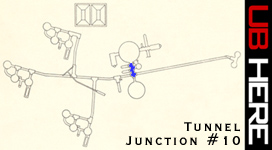Nooks
and Crannies
Even
though I tried to see every inch of the site during my time there, it
always turned out that on my next visit I would find a few places I
had overlooked. Whether it was simply a matter of inadvertently
passing some things by or that they were missed because I was
distracted by something else I'd found, there was always something new
to discover.
|

724-C,
2002: This is a shot peeking out from between one of the raw water tanks
and the short tunnel section surrounding it. That's the tank on
the left blocking a large part of the view. Portable work lights
were absolutely essential for shedding light on the vast darkness down
in the missile complex. They were particularly useful in the power
house.
|
Time
and again I would find some crawlspace, some narrow opening or some physically
inaccessible place that I hadn't had a close look at. Despite
the rather mundane nature of some areas, you never knew what you might
find on closer inspection:
-
Underneath a pile of trash
and fiberglass pipe insulation there were thousands of pages of
illustrated technical manuals on the Titan 1 complex, the guidance
system, maintenance, equipment and much more.
-
Inside a water treatment
control panel as large as a walk-in closet, I found stacks of
service logs with crew members' names and a list of work performed.
-
Humorous and even
"naughty" drawings and writings were scrawled in odd
places on beams, air ducts and steelwork.
Everywhere
it seemed, little bits of history were hidden throughout the complex,
offering clues to its past and revealing tidbits about the people who
had constructed the site and who worked there during its operation.
|

724-C,
2002: looking toward the top of the raw water tank. That's is a
level meter on top, undoubtedly connected to a float assembly rather
like the sort found in a toilet tank-- only larger.
|
|
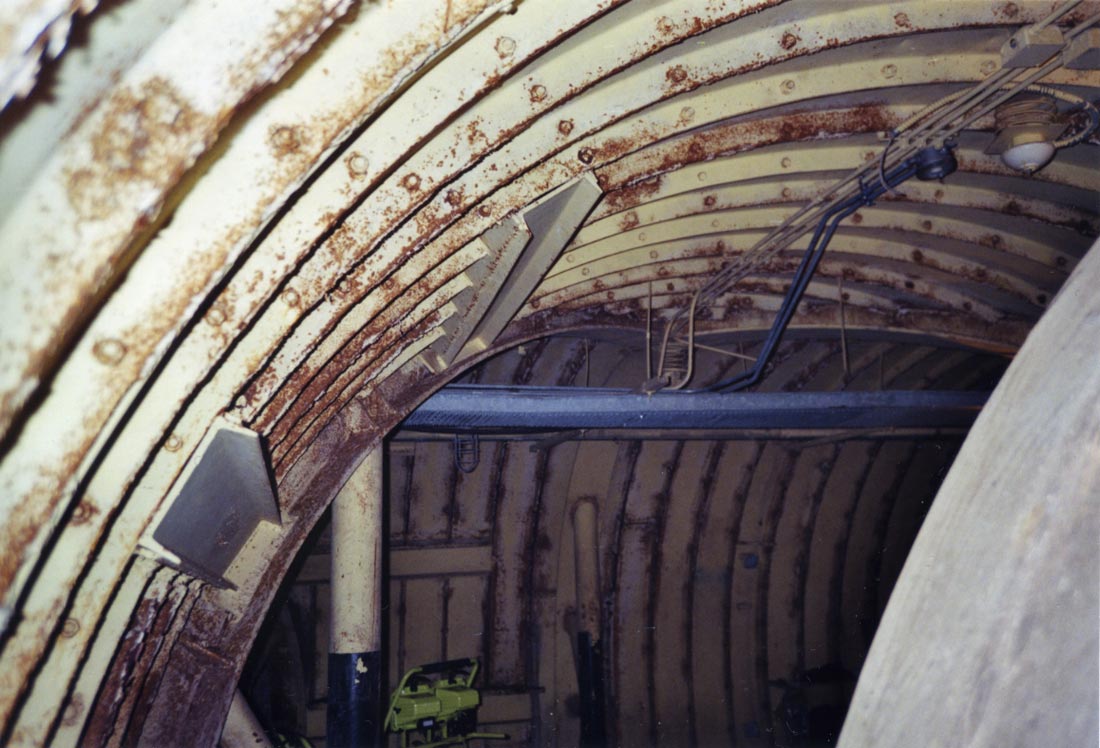
Lowry
724-C, 2002: This time peering out from the other side of the raw water
tank. Notice the meeting of 3 yoke beams at the ceiling in a giant
"Y" shape.
|
So
I started peering into all sorts of nooks and crannies to see what I
might find. Mostly I found mud or one of it's component parts,
or junk or shell casings and beer cans.
|
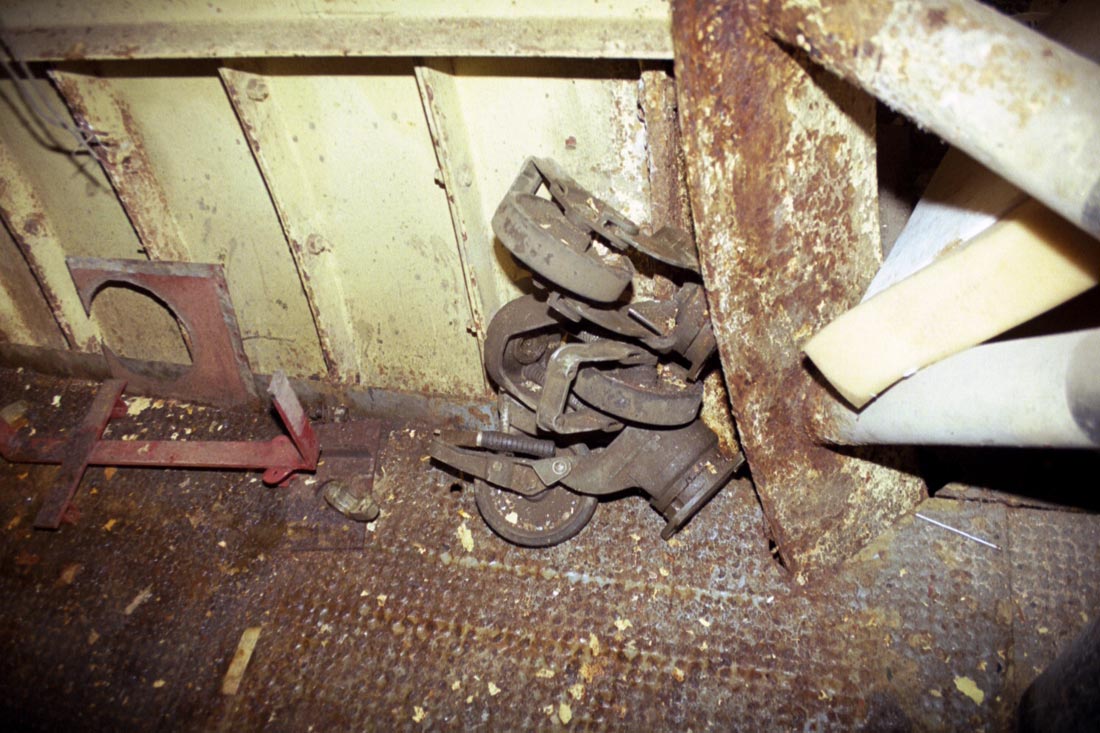
Lowry
724-C, 2002: There were standard issue heavy duty carts in each Titan I
underground complex for hauling equipment and supplies around the
site. These heavy steel casters appear to be all that's left of
the sturdy carts that once roamed the tunnels delivering stuff where
needed. I have no idea what happened to the rest of the
cart.
|
|

Larson
568-A: Near the raw water tanks, the doors to the power house can
bee seen on the right a short distance away.
Photo
courtesy of Walter Silva
|
|

Lowry
724-C, 1999: The entrance to the power house, both sides of which once
had large piles of junk and stacks of acoustical tiles taken from the
mezzanine level of the power house. It appears that the tiles were
used to help trap projectiles being fired at targets in the antenna
tunnel. During the site's operation, the tiles used to hang in
circular rows around the periphery of the dome to arrest the deafening
din caused by the generators.
|
|
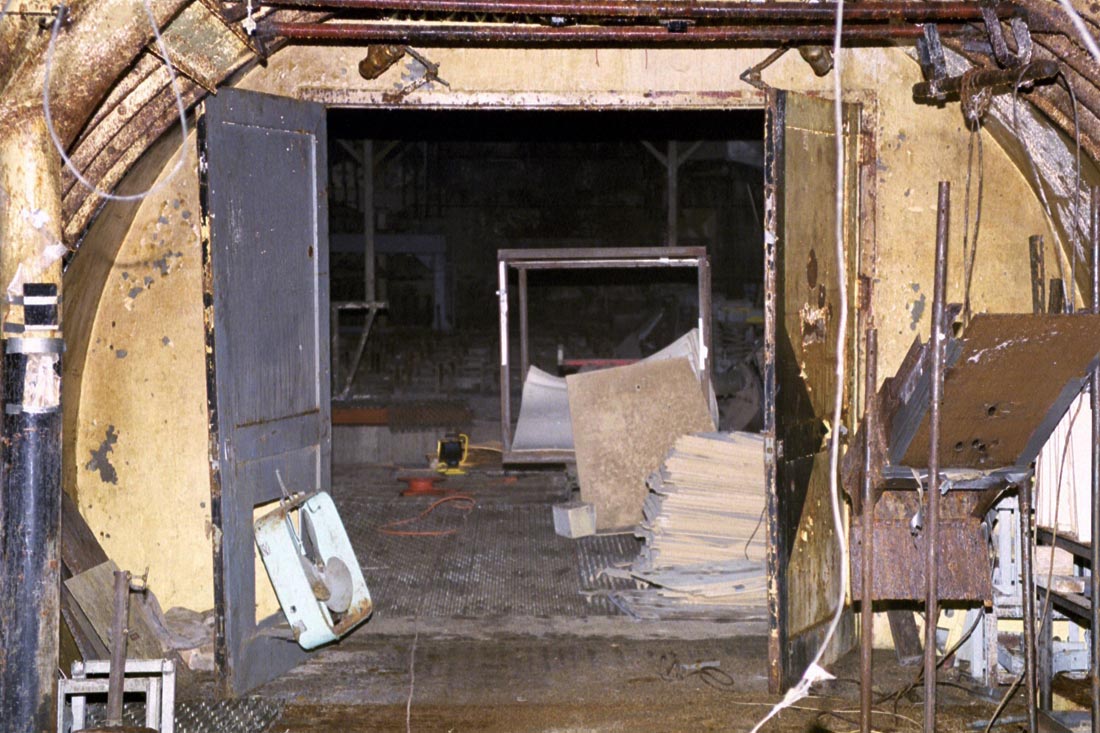
Lowry
724-C, 1999: Looking
through the doors into the Power House which has essentially been laid
to waste. Partially visible is the black diamond
on yellow marking the doors which can be seen on the door on the
right. This site was occupied after it's closure and a large
amount of junk shown in this photo can be attributed to the last
residents.
|
|
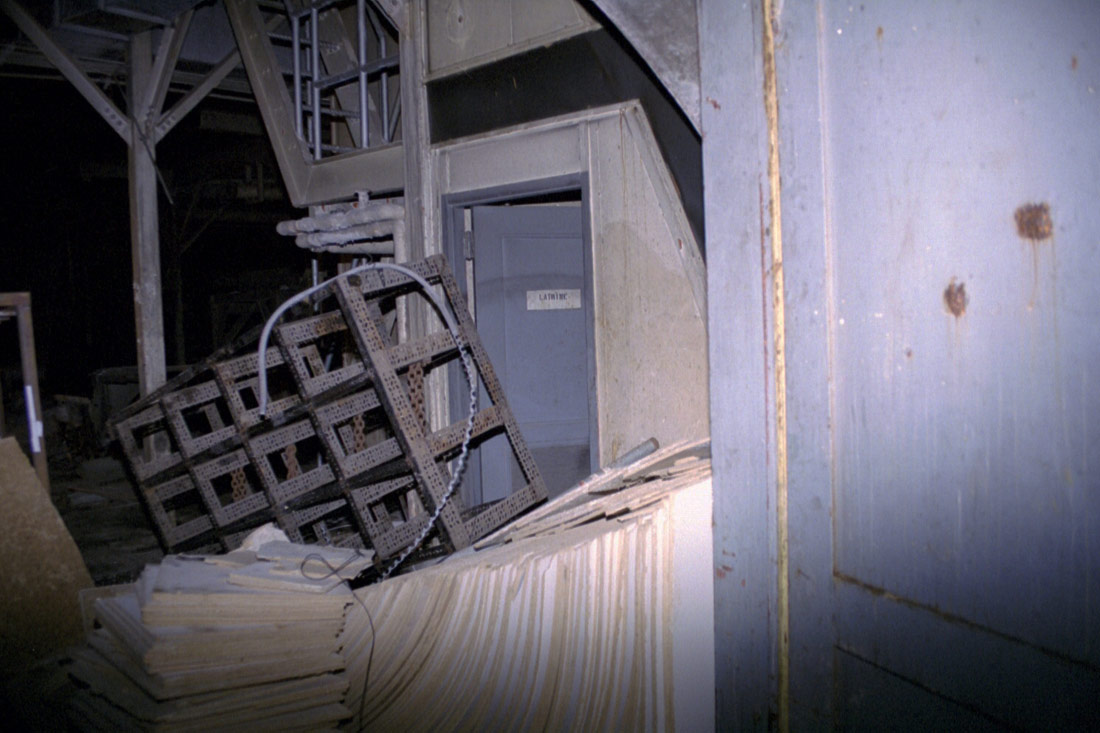
Lowry
724-C, 1999: Looking through the doors into the Power House at some of
the junk that once partially blocked the entrance. A big pile of
acoustic tiles and other refuse prevent ready access to the
latrine.
|
Over
the several years I visited this Titan site, it became a bit unnerving
to note that there were no signs of life inside. Not one living
creature did I see down there. Of course the site is rather nasty
environmentally with asbestos and lead-based paint everywhere, and the
residue of multifarious solvents, lubricants and decomposing electronic
equipment (a good source of PCBs and dioxin and a part of any complete
breakfast!). Given all this, it
is not surprising perhaps that a thriving ecology has not established
itself in the site. I suspect this is due more to the fact that
not much can live off of rust and paint chips-- the chief fauna found in
the site.
I
did however find numerous dead animals throughout the site: desiccated
rabbit corpses populated the upper area of the entry portal (there was a
crack near the added stairwell large enough for them to get in) as well
as at the bottom where some unfortunates had fallen.
Similar
ingress was available at the antenna silo doors and poor departed rats
and rabbits were noted there as well. A garter snake had found his
way all the way into the Control Center only to perish at the bottom of
one of the numerous sump wells next to another rabbit.
Coyote
feces were found on narrow beams in the entry portal-- a rather
acrobatic feat, but no coyotes were ever found (dead or alive).
Lastly, considerable numbers of rats bob like apples (all dead) in the
flooded missile silos suggesting that they fell from the doors above.
For
years, departed critters were all I saw... until 2002.
|
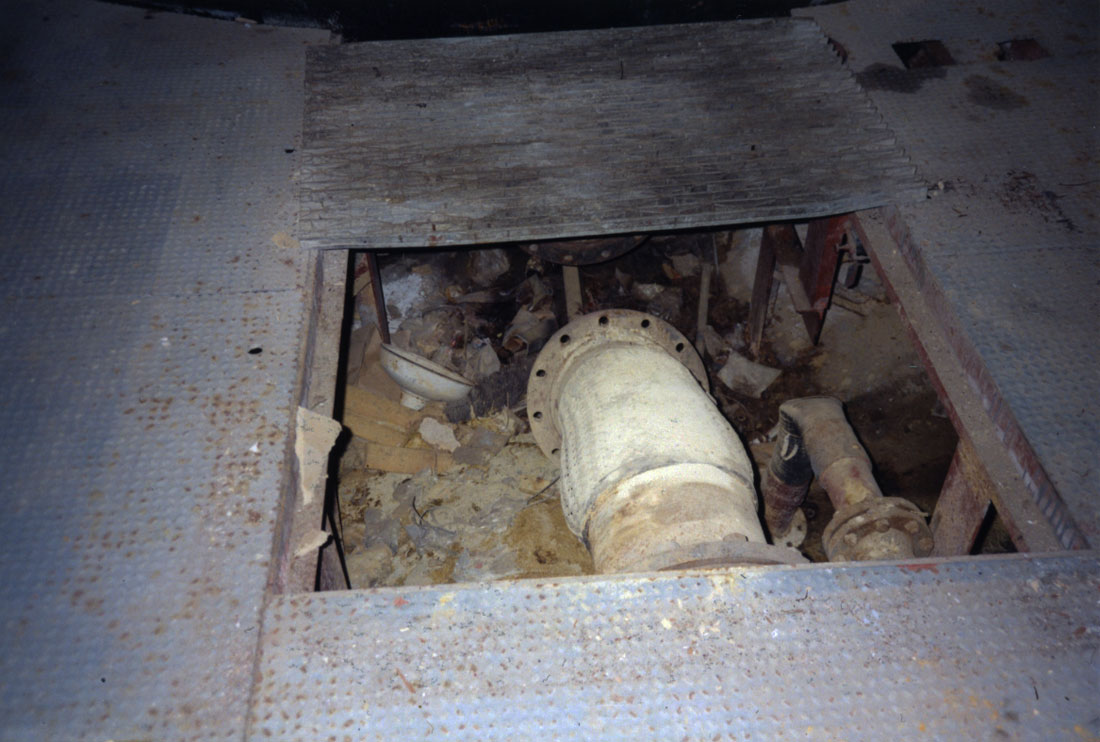
Lowry
724-C, 2002: Peering underneath the floor of the main tunnel
junction right in front of one of the raw water tanks. Here,
facing the water tank, you can see the flexible connections for the
12" outlet line and the considerably smaller inlet line, both of
which have been been disconnected.
|
The
Ephemeral Appearance of Tad
As
the site was up for sale and it appeared as though my role as
caretaker/tour guide/watchman for 724-C was nearing its end, I became
acutely aware of all the places I had not seen nor been throughout the
underground missile complex. There was the distinct possibility
of never having the chance to see or photograph a Titan I from the
inside ever again, and so I set out to try and to boldly go where I
had never gone before (very boldly it would turn out).
Some trips to the more out-of-the-way places were clearly in order.
This
meant delving into areas both dangerous and tantalizing as well as
difficult to access. It also included some out-of-the-way places
that, while not as interesting as a missile silo perhaps, were just as
mysterious, and in some instances held even greater unknowns.
In
the dangerous, tantalizing and difficult to access category there were such places as:
-
The
catwalk level of the missile silos - insane climb required
-
The
fuel cribwork in launcher silo #2 - mildly insane climbing required
-
The
catwalk level of the antenna silos - rickety ladder scaling required
-
The
flooded propellant terminals - ladder needed, crossing water of
unknown depth involved
-
The
launcher air filtration facility - very tight squeeze required to
enter
-
The
LOX Tunnel and loading vent - flooded propellant terminal must first
be crossed
In
the less-dangerous-but-still-mildly-interesting category there were:
-
The
exhaust tunnel upper level-- where the mufflers reside - simple ladder
climb
-
The
exhaust stack - access blocked by potentially hazardous blast valves
-
The
air intake lower level (dust collectors-- this turned out to be
flooded with NASTY muck)
-
Launcher
Silo #3 - blocked by a partially flooded tunnel
|

Lowry
724-C, 2002: A closer look at the 12" braided stainless steel
reinforced flexible connection to the raw water tank. This gap in
the floor has become somewhat of a waste disposal area for visitors over
the decades. You can see an empty can of Coleman's lamp oil at the
lower right, no doubt used to light someone's way many years ago.
|
I
set about trying to cover every location on my list, observing and
photographing (however poorly) as I went. It was while I was
poking about in a fairly mundane area that I discovered something rather
surprising.
|

Lowry
724-C, 2002: Looking closer at the tank itself, all the valuable
valves have been removed. I can tell you with confidence that a
12" valve is indeed an expensive piece of plumbing hardware.
Even used it probably fetched a good price.
|
I
was peering underneath the deck plating in TJ #10 near the large raw
water conduit leading to the tank and spied the only living thing I
would ever find in the site. A lone salamander.
I
don't know if it was a recent arrival, having crept in somewhere, or if
it had been born there, but I couldn't help wondering what it had been
eating if the latter was the case. Perhaps algae or insects in the
water...
|
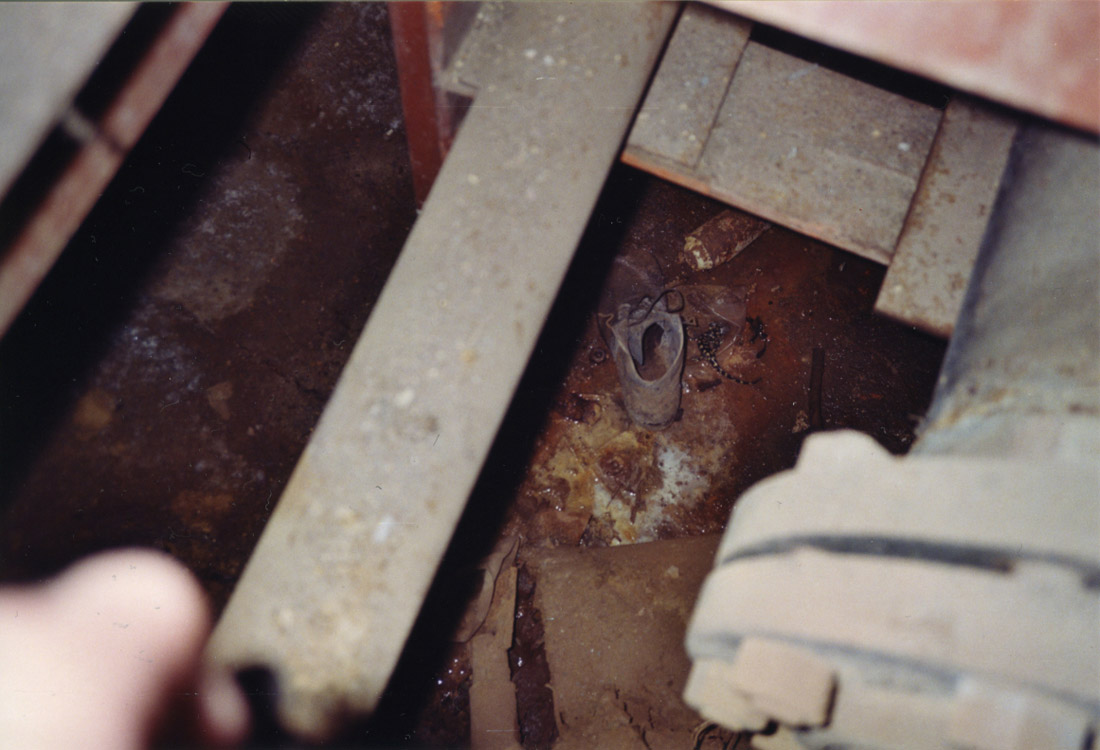
Though
difficult to see in this photo, there is the yellow-spotted black body
of a salamander next to the old shoe near the center of the frame. I
was sure he must be dead, but the next time I looked the little bugger*
was gone!
*
For the benefit of
those in the UK and elsewhere in the world where the words "little
bugger" would suggest a naughty sexual act, let me clarify that its
usage in the USA suggests in stark contrast, a cute or endearing quality
to its referent, and is not at all obscene. It is very much like
saying "cute little fellow" in the American context.
An
amusing and embarrassing anecdote was related to me by my cousin who was
in the USAF and stationed in Great Britain where he later married, made
the UK his home and raised a family.
It
was early on during his stint in the country when despite the
similarities between our two nations, he became the victim of cultural
diversity in an unwitting faux pas.
It
happened when he was courting his wife to be and struggling to
ingratiate himself to her disapproving relatives who were unimpressed
with the prospect of her marrying a "Yank". They were at
a park on a warm sunny day, perhaps celebrating a birthday or some other
family function. Everyone was cheerful and enjoying the pleasant
afternoon as the children were running about and playing on the lawn
when he casually remarked (To his deep regret he would find) that one of
her young nephews was "a cute little bugger".
A
silence followed during which the eyebrows of all within earshot seemed
to elevate as if by mechanical means to a height about 1m above their
heads. Confused and mortified by the shocked glares suddenly
falling upon him, he had no idea what transgression he was guilty
of until it was quietly explained to him by his girlfriend. He
meekly did his best to explain that what he really had intended to
convey was a offhand compliment and not an offensive and
obscene insult. He must have redeemed himself at some point as her
parents later gave their blessing for the marriage.
|
|
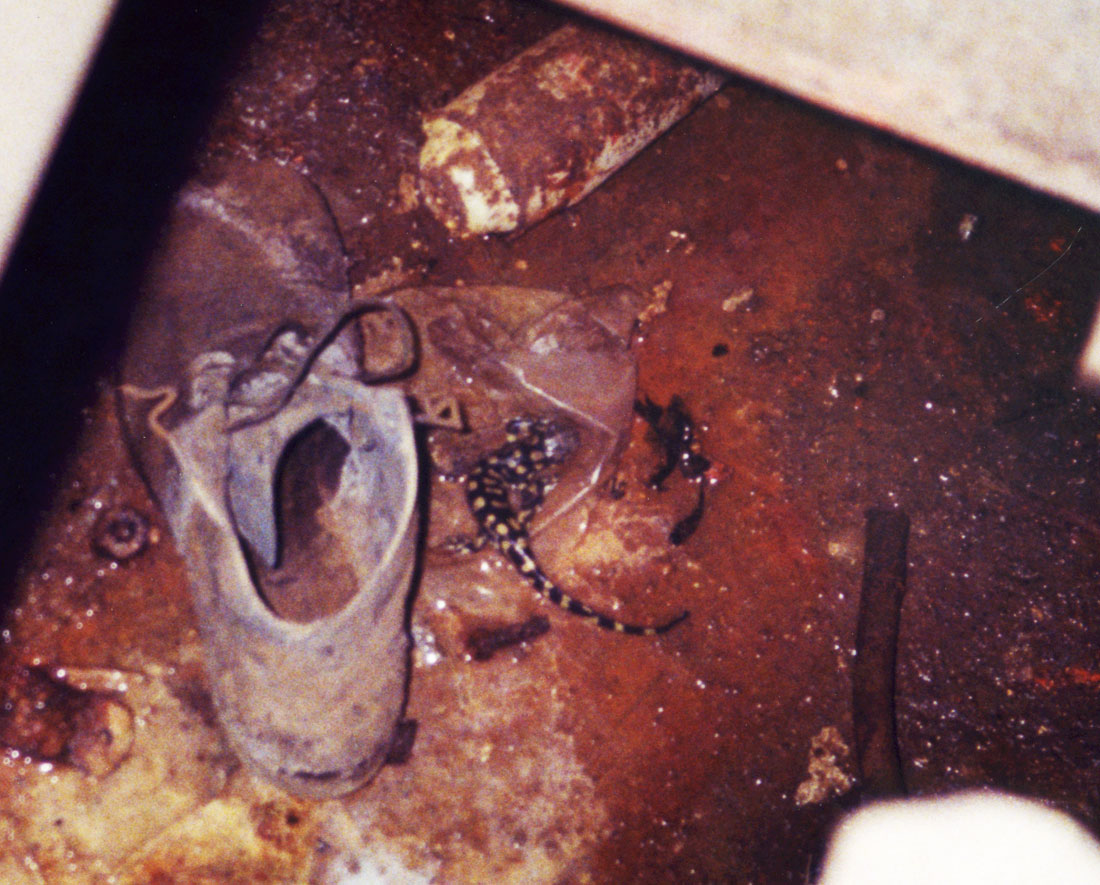
Lowry
724-C, 2002: There amongst the rust and contaminants, Tad goes about his
day 65 feet below ground in total darkness. I cannot imagine how
such an animal could survive in such an environment, much less grow to
adulthood, but regardless THERE HE IS.
|
He
was gone in a flash but I will never forget the little critter, so
unexpected was his appearance. Henceforth and ever after he shall
be known to me as Tad* (and arbitrarily
assigned male pronouns by myself). Long live Tad and may he sire many
silo-dwelling offspring to carry out his good name!
*Full
name: Sir Tad Nubbins of Moistershire
|
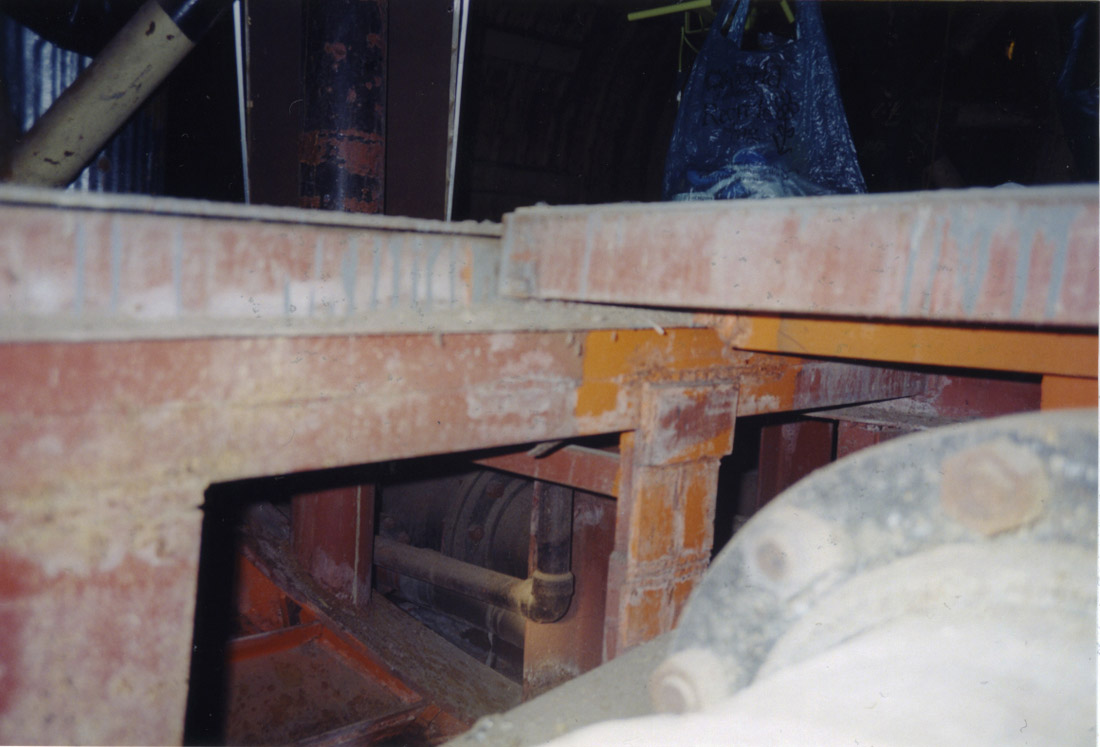
Lowry
724-C, 2002: More of the underworld just below the surface
revealing a tangle of pipes and beams. There's a lot of space down
there but moving around down there would be uncomfortable and difficult
at best.
|
The
great surprises of the main tunnel junction appear to have been
largely exhausted, but who knows what else may be hiding down there
beneath the steel floors?
|
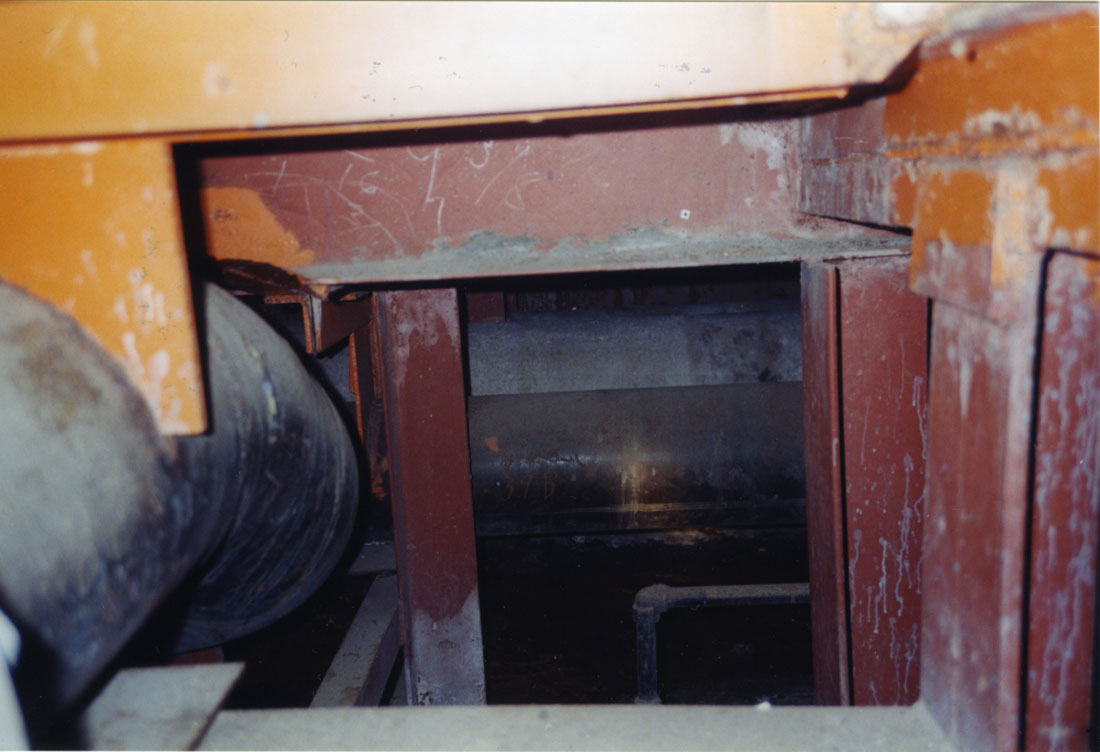
Lowry
724-C, 2002: The 12" outlet line (Aka: Firewater, since it
provided fire suppression to the launcher silos) heading off in the
direction of the launcher tunnels.
|
This
concludes this first look into the veritable foyer to the
underground Titan I complex. The entire site stretches out from
here in all directions and where to go next is completely up to you.
From
here you can go back to the Portal, to the
Power
House, the Control
Center, the Antenna
Tunnels or the Launcher
tunnels or choose a different
location from the handy regional map below.
Current
Location: Main Tunnel Junction (TJ #10) Part IV
|
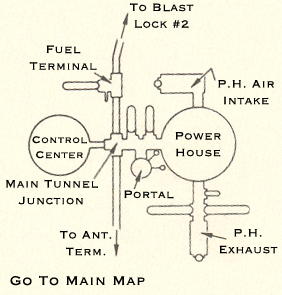
Where
would you like to go next?
|

|
Contact
| Site Map | Links |
Hosted by
InfoBunker

